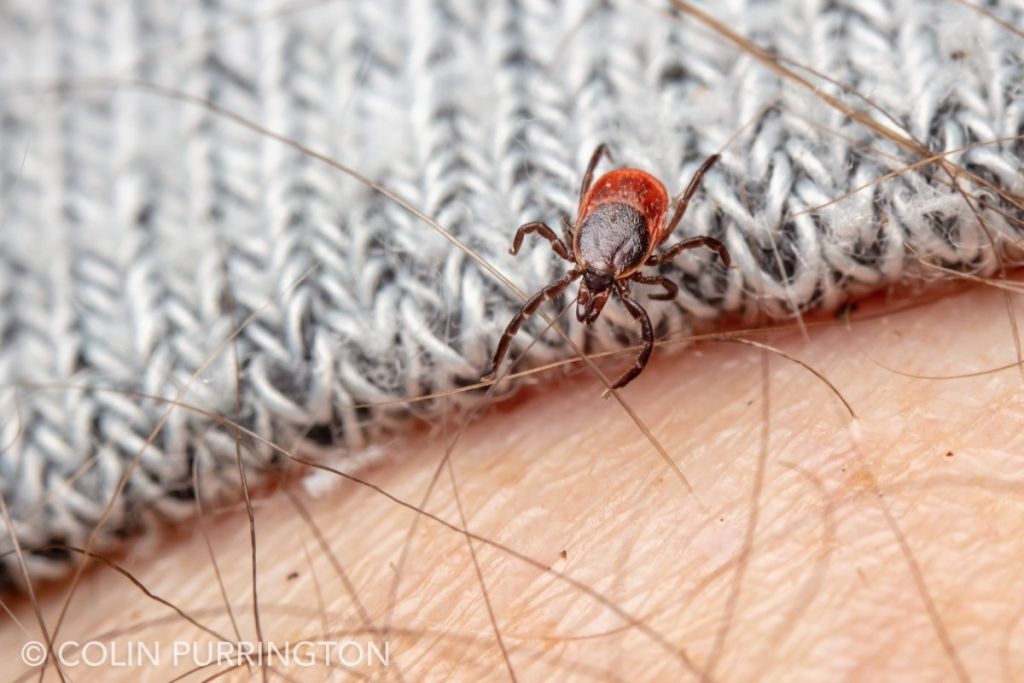I spend a lot of time outside, sometimes face-down in the weeds trying to get a photograph of something small. So I have some opinions about tick prevention and thought I’d share.

- Spray or soak shoes, socks, pants, shirts, hairband, hat, etc., with permethrin (buy online or at outdoor stores), then let dry before you using. Chemical only slowly washes out so you only need to reapply every 5th laundering or so (or after 5 months if you don’t wash your clothes). Spray your backpack with permethrin, too, because you likely set that on the ground during breaks. Do not spray permethrin on your skin. You can also buy clothing that comes pretreated with permethrin.
- Spray your clothes and skin with DEET, picaridin, para-menthane-3,8-diol, IR3535, or 2-undecanone. DEET really is the best. Note that “pure” oil of lemon eucalyptus (extracted from Corymbia citriodora) is not currently recommended by the CDC; the oil has small, variable levels of para-menthane-3,8-diol but apparently not enough. All of these repellents do not last like permethrin so reapply every few hours. Do not spray DEET on anything plastic (it will melt).
- Be suspicious of “natural” or “organic” concoctions that claim to effectively deter ticks. If one of these recipes actually works the CDC would recommend it. I’ll update this page when that happens. Similarly, avoid apps, crystals, and dietary supplements. If you need help convincing a friend to just use DEET (it’s super safe), mention that DDT is a different chemical that just happens to start with the same letter. DEET is also gluten and GMO free.
- Wear light-colored clothing so you can better see ticks. Like this person. Note that this strategy fails with tick larvae because they just too small to see unless you are wearing something pure white and have really good vision.
- Tuck your pants into your socks. Like Kanye West. You can even buy tick socks that are treated with permethrin and have a tight weave that prevents larvae from burrowing through the fabric.
- Wear tall, light-colored, glossy boots that ticks can’t easily climb. I suspect that larvae and nymphs can still climb glossy surfaces, though. I own a pair of Muck Boots and they have a neoprene surface that I suspect ticks can easily scale. I’m considering switching to something like a Gumleaf boot.
- Buy some gaiters and treat them with permethrin. Some gaiters are even designed to keep out ticks. Some even come in lime green. (NB: Lyme disease is named after Lyme, CT.)
- Buy some arm sleeves. Like gaiters, you can even buy ones that are already infused with permethrin.
- Shave your legs.
- Keep checking for ticks as you hike. If you are hiking with others, scan them for ticks, too.
- Keep a roll of duct tape handy so that you can easily remove ticks. Travel-sized lint rollers are good, too, and easily attach with a carabiner to a backpack.
- Put your field clothes into quarantine when you come home. Ideally, launder them immediately. Ticks can wander off of clothing and backpacks and show up later.
- Get naked and check for ticks. Everywhere. This is a really good reason to get a girlfriend or boyfriend even if you’re not really into them. Don’t tell them that.
- If you have limited neck mobility, invest in a nice automotive inspection mirror so you can see all the various parts of your body you never look at. You can even buy lighted ones. You can also use a selfie stick and a smart phone, but that’s risky if you accidentally forget to delete the photographs and video.
- You probably don’t want to know this but ticks are fond of lodging in ears. Get yourself an otoscope if you feel something in there. You can even buy phone attachments to get pics.
- If you find a tick that is attached, take a photograph (like this) then remove the tick. Carefully. I have a Tick Key (see one in action) but there are lots of types. Then take photographs of the bite location and of the tick. If you live in Pennsylvania, send the tick out for free testing. If you live elsewhere, put the tick in vodka or in the freezer in case you need to get it tested later.
- Take a long hot bath with a lot of soap. Ticks are hardy but you might dislodge an unattached nymph that somehow got past your first-line defenses.
- Once you are de-ticked and clean and have the laundry running, post photograph of tick on iNaturalist so you can get an identification. Here are the ticks of North America on iNaturalist. You can also send pics of ticks to TickEncounter for ID.
- Monitor the attachment spot closely. If a red spot appears, take daily photographs with ruler in frame so that doctor can assess progress of redness. Here are pics of Lyme rashes. You can even mark the progress with a Sharpie. There are plenty of other diseases transmitted by ticks, though, so don’t rely on rashes.
